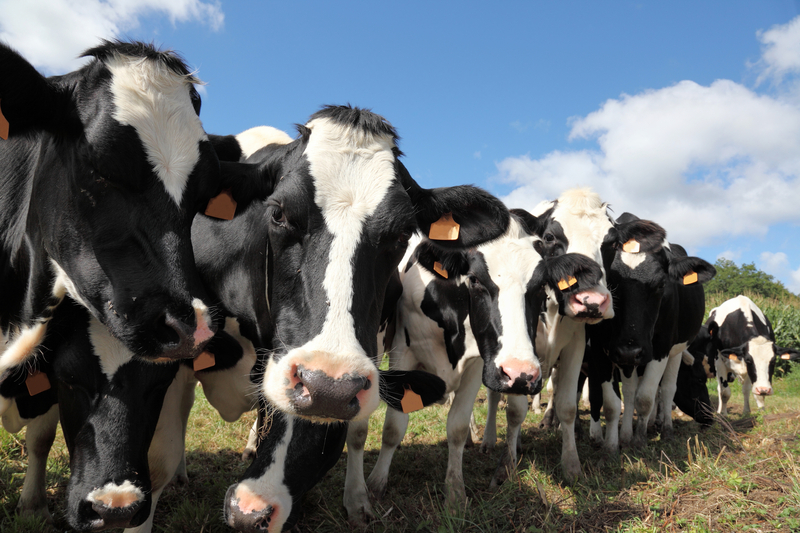Importance of Barn Ventilation

Heat Stress in Dairy Cows – Importance of Barn Ventilation
Hot weather can have severe adverse impacts on cattle health and milk production, so most dairies, especially in regions with warmer climates, have strategies to try to prevent or reduce heat stress. Scott E. Poock, DVM, DABVP, Associate Extension Professor, University of Missouri, says we need to remember that a dairy cow’s comfort zone is 45 to 65 degrees. These cows don’t handle hot weather very well.
“Today’s dairy industry is predominantly Holstein and a few Jerseys and crossbred cows. In the U.S., about 83 to 85% of the cows are Holstein, about 10 to 12% Jersey, and about 4 to 5% crossbred cows. Holsteins and Jerseys—originated in a very moderate climate and are not adapted to heat,” he says.
“I advise dairy producers to start the fans in barns when the temperature gets up to about 65 degrees, and also look at the temperature/humidity index. Certainly by 70 degrees, they need to start the sprinklers, so there will be some evaporative cooling as well,” says Poock.
Humidity makes a big difference. “Here in Missouri, this can be a problem, and you need to be moving air over those cows, and have big water drops that soak through the hair to the skin, to get enough evaporative cooling. You want more of a sprinkle than just a mist of fine droplets, and you want those drops to soak into the skin and evaporate.
When teaching students, I ask them these questions: if you are starting a dairy but only have enough money to put fans and sprinklers in one place—and you have three places that need them—where would you put them? The three places we think about are the holding area, the bedding area, and where they feed. You can’t put water over the beds, but you could put it in the holding area or over their backs when they are feeding. We ask where they should start,” he says.
The cow will spend about 12 to 14 hours in the bed, so people think they should start there. “But the place where those cows will feel the most heat stress during the day is in the holding pen, so that’s the first place to start, then the beds, and then over the feed alley. If you are in a climate where you really need a lot of evaporative cooling, you want it by the feed alley, going over their backs,” says Poock.
“Most dairies have sprinklers in that area and just rotate the sprinkling from pen to pen. Depending on how hot it is, you might run the sprinklers for a couple of minutes every 15 minutes. The water generally sprinkles or sprays over the whole pen. I was recently at a large dairy that has a type of sprinkler head that senses when a cow is there, so it only turns on if there is a cow to benefit from it. This is a more efficient use of their water.”
In a situation where sprinklers circulate around the barn, it’s not in every pen all the time. “It might be pen One for 15 minutes, and then it goes to pen Two, Three, and then Four, and circles back around again. Today, there are some amazing innovations. I can remember back when I became a veterinarian in 1987 in Wisconsin, we were moving toward tunnel ventilated barns, where the air is always moving. We don’t get a lot of heat stress in Wisconsin, but we do get some. The difference between a barn that can move the air and tunnel ventilate so there is enough air movement to really cool the cows and one that can’t is readily seen in less loss of production. There will probably still be some loss of production, but you can mitigate the amount with good ventilation.”
The benefits of good ventilation and less heat stress include greater production and better comfort. “If there is heat stress mitigation, the cows will lie down more, so this means less lameness, higher milk production, and better reproduction. We know that heat has an effect on the embryo. If we can keep the cows cooler, there will be less embryo loss. You could still have the same conception rate, but with heat stress, there may be more early pregnancy loss,” says Poock.
The health and economic gains are measurable when the cows can be kept cooler. “There will be an increase in production and better health and reproduction. Also, because there is less heat stress, the milk components like fat and protein are also better.” This more than pays for the expense and effort to keep those cows comfortable.
“Last summer at the University of Missouri dairy, we were able to do a better job with heat abatement. It wasn’t quite as hot a summer, with not as many really hot days, and we saw better production and markedly better milk components. Of all the summers I’ve been in Missouri, that one was a great one for reproduction. If we can get the cows pregnant on time, we don’t extend the lactations and we have higher production. If there are extended lactations, you end up with more fat cows, and they don’t transition as well.” It is so much better to have everything going smoothly on time.
The dairy cow is so much more specialized and complex than a beef cow. “The dairy cow is working hard all year long. I have beef cattle myself, and I am a beef cattle practitioner as well as a dairy. The dairy cow, in contrast to a beef cow, is a fine-tuned athlete. Beef cows work hard for a while, but nothing like a dairy cow,” he says.
“I was talking with one of the veterinarians in the theriogenology department recently about the changes we’ve seen in the past 25 years. We never dreamed we’d be where we are with our dairy cows today. I now work with herds that average 100 pounds of milk and 50% conception, and Holsteins with butterfat above 4% and protein at 3.4. It takes a lot of energy to do that, and to then get pregnant on top of this is phenomenal for the Holstein cows,” says Poock.
“If we had as much data in the beef industry as the dairy industry does, we’d be farther ahead there, too. The beef industry is a bit behind, but we also have a much more diverse environment for beef cattle. The dairy cows are a little more cookie-cutter, the same—not as much as pigs or poultry, but much more so than beef cows.”
In some regions like the South, where the climate isn’t as conducive to cow comfort, dairying is a bit more challenging. “Missouri is like the Southeast, and our challenge is humidity and the fact that we don’t get very good cooling at night. This makes a big difference, as opposed to places like West Texas and other arid climates. At night, the temperature may drop down into the 60s, and if the wind is blowing, it cools the cattle nicely.” That dairy cow can withstand a little more heat during the day; she doesn’t keep building core temperature because she can cool down again.
“In Wisconsin, for instance, when we do get some heat stress, it still cools off at night, down into the 50s and 60s. A cow’s core temperature is probably going to peak during the night but can drop down again toward morning. Sometimes we are tempted to not run the sprinklers at night or to think we don’t need to run the fans, but it takes time to get rid of that body heat; it’s almost more important to use these cooling methods at night to allow those cows to get a break from the heat stress,” says Poock. Cows are always healthier if they have less stress and are comfortable, because too much stress hinders the immune system.
Barn Ventilation
A ventilation system for dairy cows in barns or sheds must provide fresh air year-round, but in summer, it is crucial to have fast-moving air where the cows are resting, to provide adequate cooling, whether the barn is ventilated naturally or by mechanical means such as fans. Regardless of the method, the design should facilitate optimum air flow.
Even though 85% of free-stall facilities in Wisconsin have natural ventilation, for instance, they don’t always have adequate cooling. Wind shadows created by nearby buildings, seasonal cornfields or other obstructions, barn orientation, and other factors can limit the proper function of these systems.
Mechanical ventilation is facilitated by fans, and usually defined as either Naturally Ventilated barns where the side walls are open, or Tunnel Ventilated Barns where exhaust fans are located along the width of the barn and the air flow is parallel to the feed lane. Some barns have cross ventilation, where exhaust fans are located along the width of the barn and air flow is perpendicular to the feed lane. Some systems combine natural and mechanical ventilation, with fans over the stalls, down the feed lane, with either ridge cupula fans or an open ridge to assist with removing the hot, buoyant air from the barn.
The main focus should be on keeping cows cool so they can remain lying down longer, and it is important to understand the role of a fan system. What you need will be based on the cow’s stage of lactation or whether she is dry, the climate, and the building. For many years, fans were considered the least important aspect, but now the industry has become better focused on why they are needed. Even just a few years ago, people thought that just about any fan would work, without understanding a fan’s capability.
There are various ways to create ventilation, but even with natural ventilation, most barns will probably need fans. “I haven’t ever been anywhere that you could get away with just air flow due to the barns construction. Now we are talking about 14-foot sidewalls to make sure we get the movement, and there are also some cross-ventilated barns, but in a really humid environment, those don’t work as well. In a dry environment, they work really well, however,” he says.
Tunnel
Ventilated barns work well, but the key is having enough fan capacity to help move the air. “On a winter day, about 4 air exchanges per hour is fine, but when you are facing heat stress in the summer, probably 10 to 15 exchanges per hour is much better. This helps with evaporative cooling.”
By Heather Smith Thomas
American Dairymen Magazine https://americandairymen.com/
For Cattle Industry News check out the American Cattlemen
If you enjoy the Outdoors Check out The Iowa Sportsman



